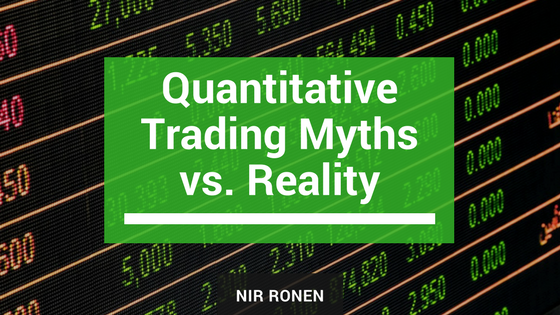There are many common misconceptions about the field of quantitative or algorithmic trading. A Google search will return many derogatory articles accusing this type of specialized trading of overturning the traditional Wall Street model. The truth is, there is a lot that people don’t understand about quantitative trading and, involving complex algorithms and platforms to inform trading decisions, it is really impossible for anyone not directly involved to have a full understanding. In this article, I hope to dispel any misconceptions people may have formed about quantitative trading. I take a lot of pride in the work I do and am aware of all the kinds of skills and expertise one must possess in order to succeed in this field. So to that end, here are some of the most common myths about quantitative trading and the truths to back them up.
Myth #1: Quantitative trading is done by computers and threatens to take jobs away from human traders.
Reality: Computers are fundamental to quantitative trading; however, they are useless without the sophisticated human-developed algorithms they process in order to inform quants’ trading decisions. The human element of quantitative trading transcends the computers. For the most part, quantitative trading relies first and foremost on the brainpower of traders to develop algorithms that they then backtest against historical data and put them into play to capitalize on market trends.
Myth #2: Quantitative trading is not as accurate as traditional trading.
Reality: Quantitative trading fell under a lot of criticism with the start of the Great Recession in 2008. People claimed that the computer models used to process algorithms were not accurate enough to inform decisions regarding the buying and selling of stocks and thus contributed to the financial crisis. A loss of faith in quantitative trading methods resulted in a huge sell-off in the markets. However, before placing blame on the infrastructures used for algorithms, one should also consider the margin of error that comes from acting on emotion and impulse rather than data and logic. Computers make the influx of data from trading decisions more manageable. “Overcoming emotion is one of the most pervasive problems with trading. Be it fear or greed, when trading, emotion serves only to stifle rational thinking, which usually leads to losses. Computers and mathematics do not possess emotions, so quantitative trading eliminates this problem,” Investopedia explains.
Consequently, in most cases, machines should help in mitigating overreactions, illogical or emotionally-driven behavior and actually curb unusual markets moves as opposed to exacerbating them.
Myth #3: Quantitative and traditional trading can’t mix.
Reality: Conversely, quantitative traders and traditional traders share a mutually beneficial relationship and the lines between traditional and quantitative trading methods are becoming ever more blurred as technology advances. Traditional traders are starting to realize the importance of big data for making informed trading decisions, while quants still recognize and abide by core fundamental trading techniques. According to Rosemary Mercado, chief investment officer of QS Investors, “A lot of fundamental firms have adopted quantitative practices to take advantage of tactics that were successful, and quants have adopted some fundamental practices.”
There are many more quantitative trading myths in circulation, but if I can offer some parting advice, it would be to always do your research before making assumptions. Quantitative trading is a valuable and growing sector of the stock market.

